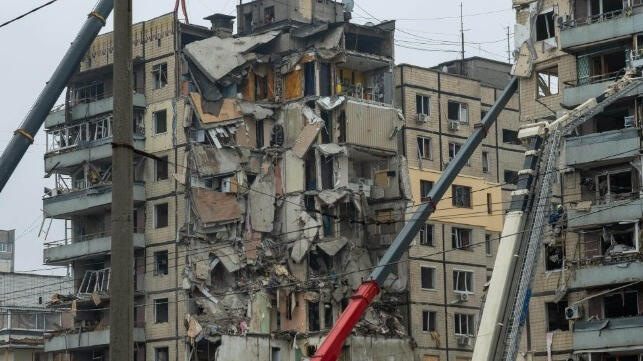UK Intel: Ancient Anti-Ship Missile Caused Deadly Apartment Blast

An anti-ship missile caused the deadly blast at an apartment complex in Dnipro, Ukraine on Friday, according to British intelligence.
The UK believes that a Kh-22 heavyweight anti-ship missile (NATO reporting name AS-4 Kitchen) was "highly likely" the munition that struck a large apartment complex in Dnipro, killing at least 40 people. Russia has used the bomber-launched Kh-22 extensively over the course of the invasion, primarily for deep strike against targets behind the front lines.
The Kh-22 is a designated "carrier-killer" dating to the late Soviet era, and it is nuclear-capable to offset any imprecision in guidance. It is the size of a tree trunk, nearly 40 feet long by three feet in diameter, and it weighs six tonnes loaded. Carrying one tonne of explosives in its conventional role, it is designed to create a 15-foot hole in the hull of a carrier.
The original variant of the Kh-22 descends on its target from high altitude at a speed of Mach 3.3, making it difficult to intercept. Delivered by a supersonic bomber, the Tu-22, it has a range of 180 miles. In its day, the Kh-22 was considered dangerous enough that it helped motivate the U.S. Navy to develop the E-2 Hawkeye, F-14 Tomcat and Ticonderoga-class cruiser - platforms capable of keeping the bomber and its payload at arms length from U.S. Navy carriers, according to historian Tom Cooper.
The Kh-22's radar guidance system was purpose-built to lock onto large steel ships during terminal descent. While the missile has a secondary land-attack role, it was never designed to identify buildings, and its record in practice has been mixed. "[Kh-22] Kitchen is notoriously inaccurate when used against ground targets as its radar guidance system is poor at differentiating targets in urban area," noted the UK MoD in an assessment Monday.
This has not stopped Russian forces from using Soviet-era stocks of the weapon in Ukraine, resulting in extensive collateral damage. The Kh-22 was responsible for the disastrous blast at the Kremenchuk shopping mall in June 2022, which claimed at least 20 lives and injured 56 people. A Kh-22 from the same salvo hit a nearby machinery plant, which had been used for the repair of Ukrainian armored vehicles; the strike on the Kremenchuk mall may have been aimed at the factory but hit 1,500 feet off target - typical of the margin of error for the Kh-22, according to security analyst Sebastien Roblin.
